2009 SUBARU TRIBECA Intake
[x] Cancel search: IntakePage 1736 of 2453
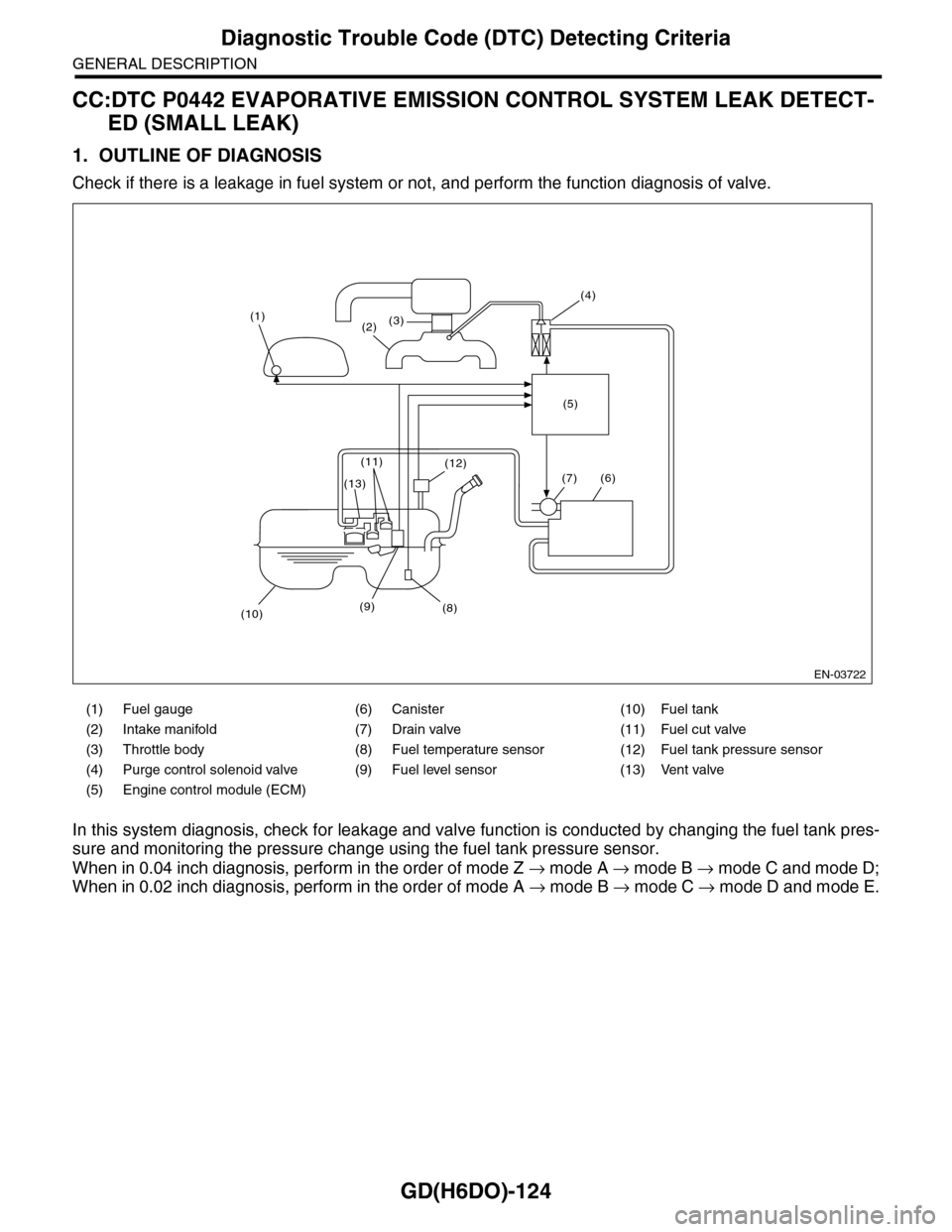
GD(H6DO)-124
Diagnostic Trouble Code (DTC) Detecting Criteria
GENERAL DESCRIPTION
CC:DTC P0442 EVAPORATIVE EMISSION CONTROL SYSTEM LEAK DETECT-
ED (SMALL LEAK)
1. OUTLINE OF DIAGNOSIS
Check if there is a leakage in fuel system or not, and perform the function diagnosis of valve.
In this system diagnosis, check for leakage and valve function is conducted by changing the fuel tank pres-
sure and monitoring the pressure change using the fuel tank pressure sensor.
When in 0.04 inch diagnosis, perform in the order of mode Z → mode A → mode B → mode C and mode D;
When in 0.02 inch diagnosis, perform in the order of mode A → mode B → mode C → mode D and mode E.
(1) Fuel gauge (6) Canister (10) Fuel tank
(2) Intake manifold (7) Drain valve (11) Fuel cut valve
(3) Throttle body (8) Fuel temperature sensor (12) Fuel tank pressure sensor
(4) Purge control solenoid valve (9) Fuel level sensor (13) Vent valve
(5) Engine control module (ECM)
EN-03722
(1)(2)(3)
(4)
(5)
(6)
(8)
(12)
(9)(10)
(13)
(11)
(7)
Page 1737 of 2453
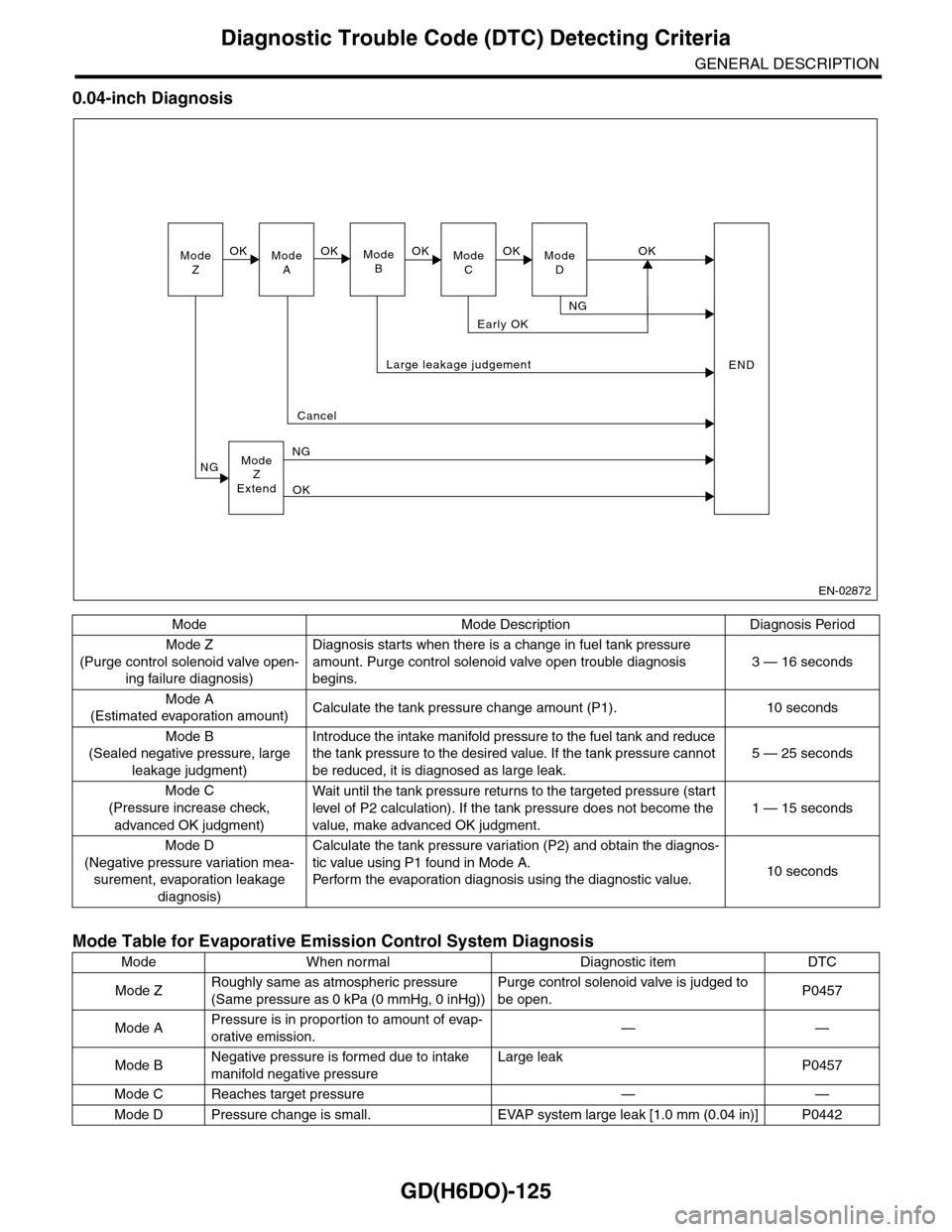
GD(H6DO)-125
Diagnostic Trouble Code (DTC) Detecting Criteria
GENERAL DESCRIPTION
0.04-inch Diagnosis
Mode Mode Description Diagnosis Period
Mode Z
(Purge control solenoid valve open-
ing failure diagnosis)
Diagnosis starts when there is a change in fuel tank pressure
amount. Purge control solenoid valve open trouble diagnosis
begins.
3 — 16 seconds
Mode A
(Estimated evaporation amount)Calculate the tank pressure change amount (P1). 10 seconds
Mode B
(Sealed negative pressure, large
leakage judgment)
Introduce the intake manifold pressure to the fuel tank and reduce
the tank pressure to the desired value. If the tank pressure cannot
be reduced, it is diagnosed as large leak.
5 — 25 seconds
Mode C
(Pressure increase check,
advanced OK judgment)
Wait until the tank pressure retur ns to the targeted pressure (star t
level of P2 calculation). If the tank pressure does not become the
value, make advanced OK judgment.
1 — 15 seconds
Mode D
(Negative pressure variation mea-
surement, evaporation leakage
diagnosis)
Calculate the tank pressure variation (P2) and obtain the diagnos-
tic value using P1 found in Mode A.
Pe r fo r m t he eva po ra ti o n d ia g no si s u si n g t h e d ia g no st i c val u e.10 seconds
Mode Table for Evaporative Emission Control System Diagnosis
Mode When normal Diagnostic item DTC
Mode ZRoughly same as atmospheric pressure
(Same pressure as 0 kPa (0 mmHg, 0 inHg))
Purge control solenoid valve is judged to
be open.P0457
Mode APressure is in proportion to amount of evap-
orative emission.——
Mode BNegative pressure is formed due to intake
manifold negative pressure
Large leakP0457
Mode C Reaches target pressure — —
Mode D Pressure change is small. EVAP system large leak [1.0 mm (0.04 in)] P0442
ModeZModeAModeBModeCModeD
OKOKOKOKOK
NG
Early OK
Large leakage judgement
Cancel
ModeZExtend
NG
NG
OK
END
EN-02872
Page 1738 of 2453
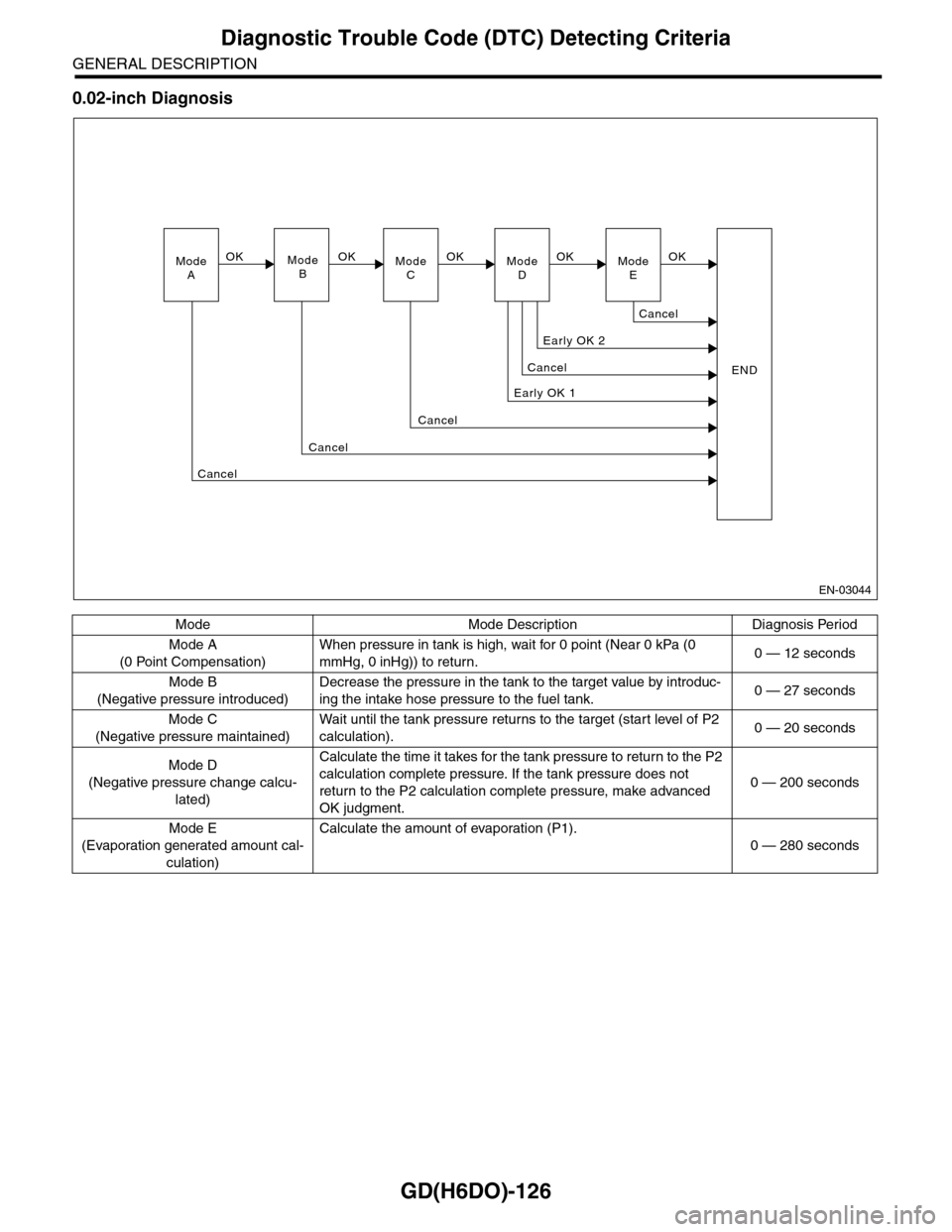
GD(H6DO)-126
Diagnostic Trouble Code (DTC) Detecting Criteria
GENERAL DESCRIPTION
0.02-inch Diagnosis
Mode Mode Description Diagnosis Period
Mode A
(0 Point Compensation)
When pressure in tank is high, wait for 0 point (Near 0 kPa (0
mmHg, 0 inHg)) to return.0 — 12 seconds
Mode B
(Negative pressure introduced)
Decrease the pressure in the tank to the target value by introduc-
ing the intake hose pressure to the fuel tank.0 — 27 seconds
Mode C
(Negative pressure maintained)
Wa i t u nt i l t h e t a nk pr e ss ur e r et u r ns to t he t ar g e t ( s ta r t leve l o f P 2
calculation).0 — 20 seconds
Mode D
(Negative pressure change calcu-
lated)
Calculate the time it takes for the tank pressure to return to the P2
calculation complete pressure. If the tank pressure does not
return to the P2 calculation complete pressure, make advanced
OK judgment.
0 — 200 seconds
Mode E
(Evaporation generated amount cal-
culation)
Calculate the amount of evaporation (P1).
0 — 280 seconds
EN-03044
ModeAModeBModeCModeD
OKOKOK
Early OK 1
Cancel
Cancel
END
Cancel
Cancel
Early OK 2
OKModeE
Cancel
OK
Page 1739 of 2453
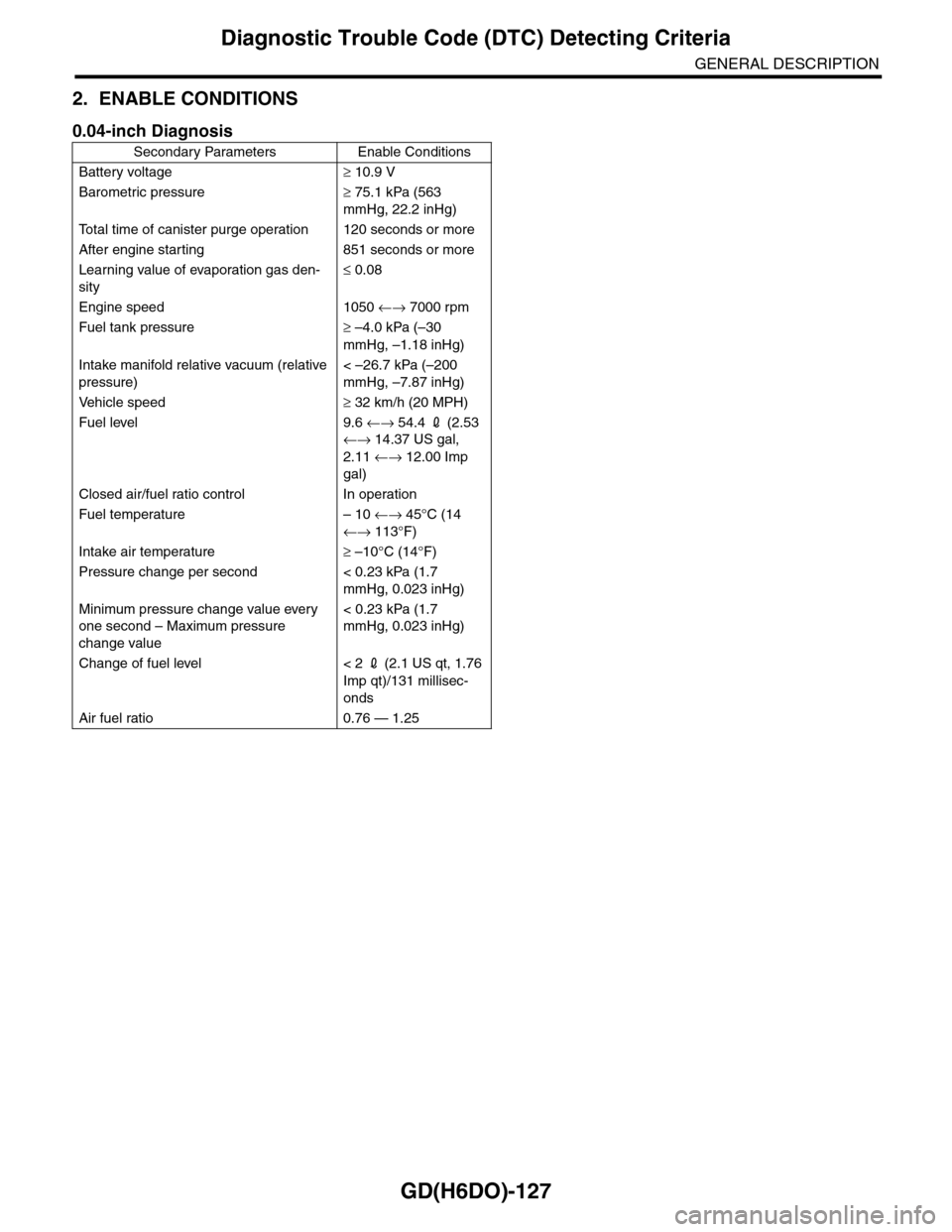
GD(H6DO)-127
Diagnostic Trouble Code (DTC) Detecting Criteria
GENERAL DESCRIPTION
2. ENABLE CONDITIONS
0.04-inch Diagnosis
Secondary Parameters Enable Conditions
Battery voltage≥ 10.9 V
Barometric pressure≥ 75.1 kPa (563
mmHg, 22.2 inHg)
To t a l t i m e o f c a n i s t e r p u r g e o p e r a t i o n 1 2 0 s e c o n d s o r m o r e
After engine starting 851 seconds or more
Learning value of evaporation gas den-
sity
≤ 0.08
Engine speed 1050 ←→ 7000 rpm
Fuel tank pressure≥ –4.0 kPa (–30
mmHg, –1.18 inHg)
Intake manifold relative vacuum (relative
pressure)
< –26.7 kPa (–200
mmHg, –7.87 inHg)
Ve h i c l e s p e e d≥ 32 km/h (20 MPH)
Fuel level 9.6 ←→ 54.4 2 (2.53
←→ 14.37 US gal,
2.11 ←→ 12.00 Imp
gal)
Closed air/fuel ratio control In operation
Fuel temperature – 10 ←→ 45°C (14
←→ 113°F)
Intake air temperature≥ –10°C (14°F)
Pressure change per second < 0.23 kPa (1.7
mmHg, 0.023 inHg)
Minimum pressure change value every
one second – Maximum pressure
change value
< 0.23 kPa (1.7
mmHg, 0.023 inHg)
Change of fuel level < 2 2 (2.1 US qt, 1.76
Imp qt)/131 millisec-
onds
Air fuel ratio 0.76 — 1.25
Page 1740 of 2453
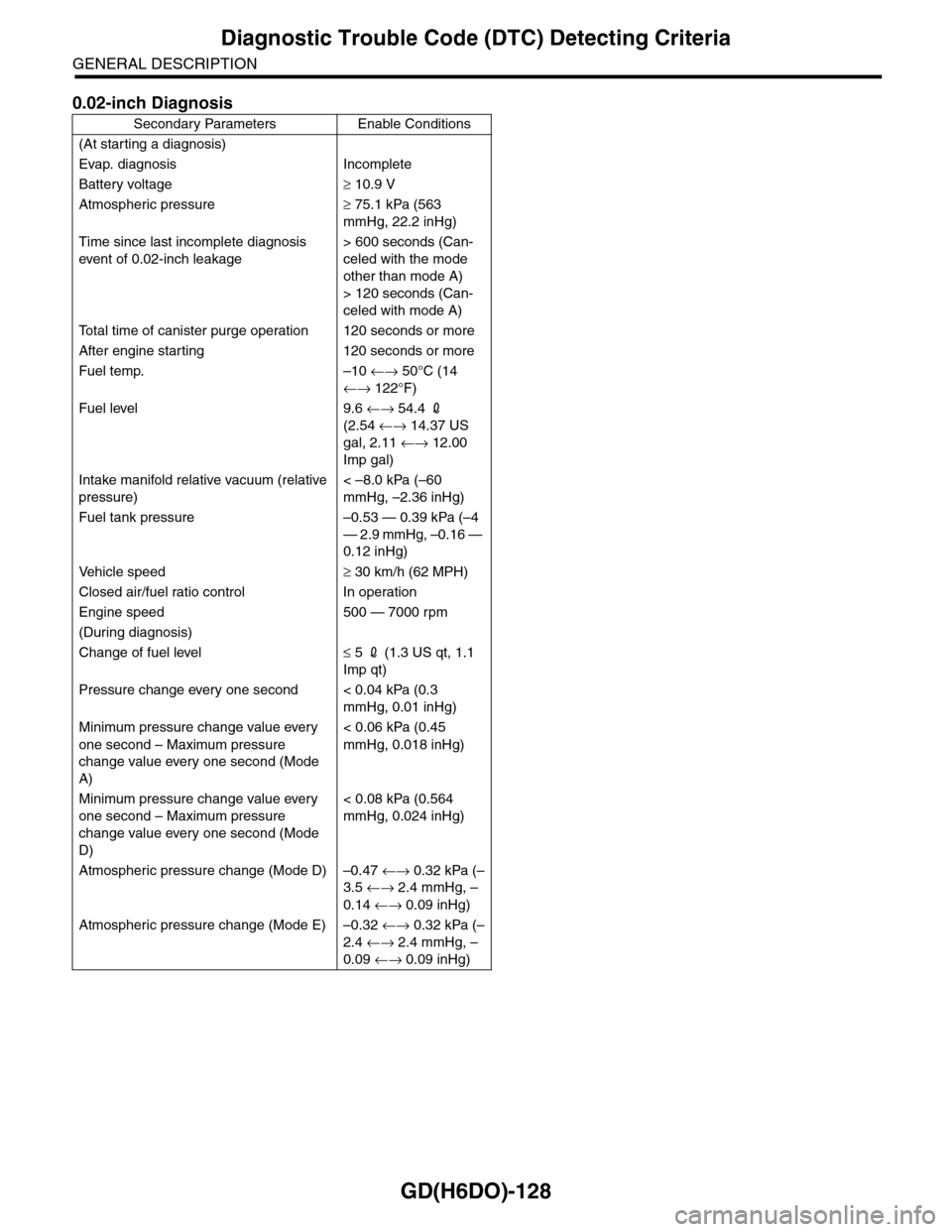
GD(H6DO)-128
Diagnostic Trouble Code (DTC) Detecting Criteria
GENERAL DESCRIPTION
0.02-inch Diagnosis
Secondary Parameters Enable Conditions
(At starting a diagnosis)
Evap. diagnosis Incomplete
Battery voltage≥ 10.9 V
Atmospheric pressure≥ 75.1 kPa (563
mmHg, 22.2 inHg)
Time since last incomplete diagnosis
event of 0.02-inch leakage
> 600 seconds (Can-
celed with the mode
other than mode A)
> 120 seconds (Can-
celed with mode A)
To t a l t i m e o f c a n i s t e r p u r g e o p e r a t i o n 1 2 0 s e c o n d s o r m o r e
After engine starting 120 seconds or more
Fuel temp. –10 ←→ 50°C (14
←→ 122°F)
Fuel level 9.6 ←→ 54.4 2
(2.54 ←→ 14.37 US
gal, 2.11 ←→ 12.00
Imp gal)
Intake manifold relative vacuum (relative
pressure)
< –8.0 kPa (–60
mmHg, –2.36 inHg)
Fuel tank pressure –0.53 — 0.39 kPa (–4
— 2.9 mmHg, –0.16 —
0.12 inHg)
Ve h i c l e s p e e d≥ 30 km/h (62 MPH)
Closed air/fuel ratio control In operation
Engine speed 500 — 7000 rpm
(During diagnosis)
Change of fuel level≤ 5 2 (1.3 US qt, 1.1
Imp qt)
Pressure change every one second < 0.04 kPa (0.3
mmHg, 0.01 inHg)
Minimum pressure change value every
one second – Maximum pressure
change value every one second (Mode
A)
< 0.06 kPa (0.45
mmHg, 0.018 inHg)
Minimum pressure change value every
one second – Maximum pressure
change value every one second (Mode
D)
< 0.08 kPa (0.564
mmHg, 0.024 inHg)
Atmospheric pressure change (Mode D) –0.47 ←→ 0.32 kPa (–
3.5 ←→ 2.4 mmHg, –
0.14 ←→ 0.09 inHg)
Atmospheric pressure change (Mode E) –0.32 ←→ 0.32 kPa (–
2.4 ←→ 2.4 mmHg, –
0.09 ←→ 0.09 inHg)
Page 1744 of 2453
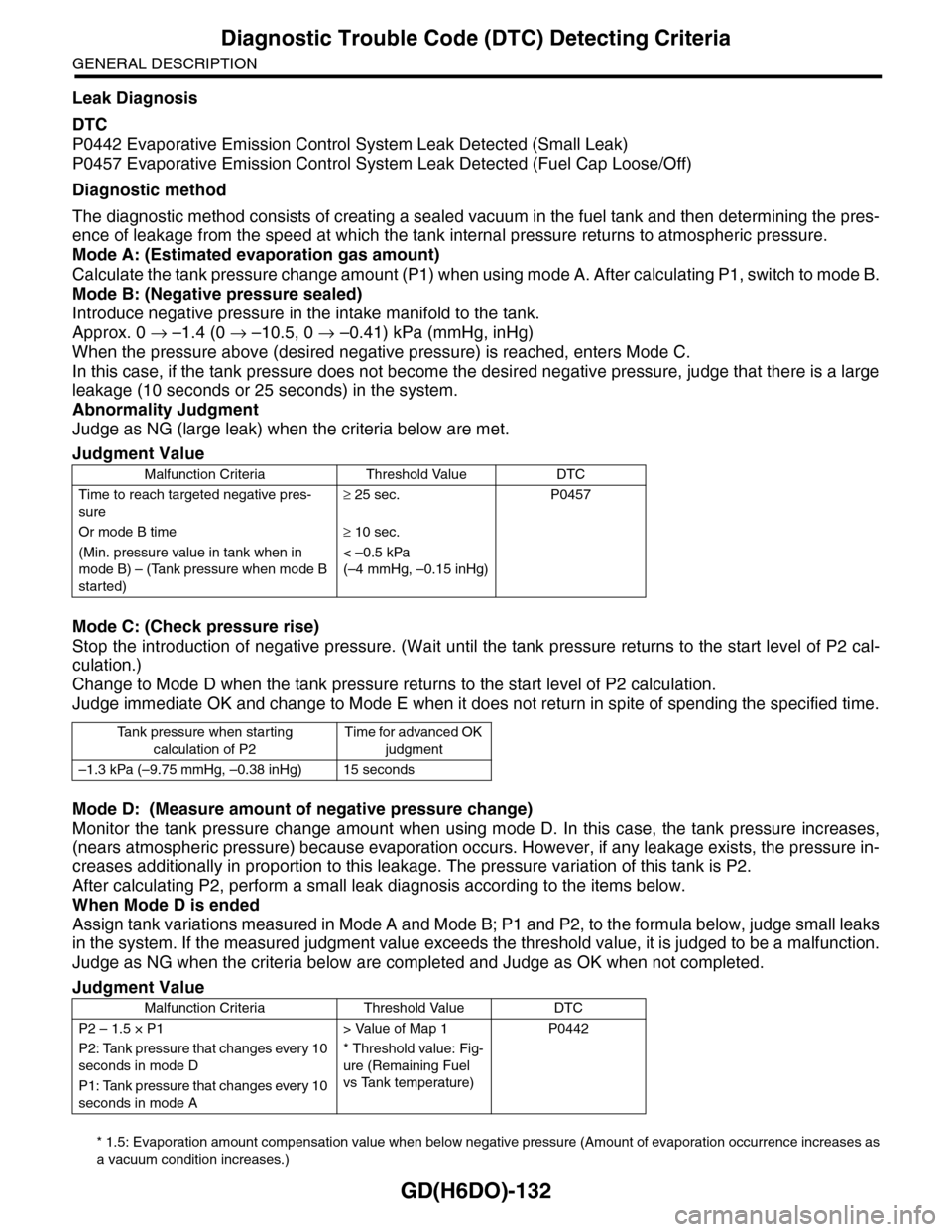
GD(H6DO)-132
Diagnostic Trouble Code (DTC) Detecting Criteria
GENERAL DESCRIPTION
Leak Diagnosis
DTC
P0442 Evaporative Emission Control System Leak Detected (Small Leak)
P0457 Evaporative Emission Control System Leak Detected (Fuel Cap Loose/Off)
Diagnostic method
The diagnostic method consists of creating a sealed vacuum in the fuel tank and then determining the pres-
ence of leakage from the speed at which the tank internal pressure returns to atmospheric pressure.
Mode A: (Estimated evaporation gas amount)
Calculate the tank pressure change amount (P1) when using mode A. After calculating P1, switch to mode B.
Mode B: (Negative pressure sealed)
Introduce negative pressure in the intake manifold to the tank.
Approx. 0 → –1.4 (0 → –10.5, 0 → –0.41) kPa (mmHg, inHg)
When the pressure above (desired negative pressure) is reached, enters Mode C.
In this case, if the tank pressure does not become the desired negative pressure, judge that there is a large
leakage (10 seconds or 25 seconds) in the system.
Abnormality Judgment
Judge as NG (large leak) when the criteria below are met.
Mode C: (Check pressure rise)
Stop the introduction of negative pressure. (Wait until the tank pressure returns to the start level of P2 cal-
culation.)
Change to Mode D when the tank pressure returns to the start level of P2 calculation.
Judge immediate OK and change to Mode E when it does not return in spite of spending the specified time.
Mode D: (Measure amount of negative pressure change)
Monitor the tank pressure change amount when using mode D. In this case, the tank pressure increases,
(nears atmospheric pressure) because evaporation occurs. However, if any leakage exists, the pressure in-
creases additionally in proportion to this leakage. The pressure variation of this tank is P2.
After calculating P2, perform a small leak diagnosis according to the items below.
When Mode D is ended
Assign tank variations measured in Mode A and Mode B; P1 and P2, to the formula below, judge small leaks
in the system. If the measured judgment value exceeds the threshold value, it is judged to be a malfunction.
Judge as NG when the criteria below are completed and Judge as OK when not completed.
* 1.5: Evaporation amount compensation value when below negative pressure (Amount of evaporation occurrence increases as
a vacuum condition increases.)
Judgment Value
Malfunction Criteria Threshold Value DTC
Time to reach targeted negative pres-
sure
≥ 25 sec. P0457
Or mode B time≥ 10 sec.
(Min. pressure value in tank when in
mode B) – (Tank pressure when mode B
started)
< –0.5 kPa
(–4 mmHg, –0.15 inHg)
Ta n k p r e s s u r e w h e n s t a r t i n g
calculation of P2
Time for advanced OK
judgment
–1.3 kPa (–9.75 mmHg, –0.38 inHg) 15 seconds
Judgment Value
Malfunction Criteria Threshold Value DTC
P2 – 1.5 × P1 > Value of Map 1 P0442
P2: Tank pressure that changes every 10
seconds in mode D
* Threshold value: Fig-
ure (Remaining Fuel
vs Tank temperature)
P1: Tank pressure that changes every 10
seconds in mode A
Page 1745 of 2453
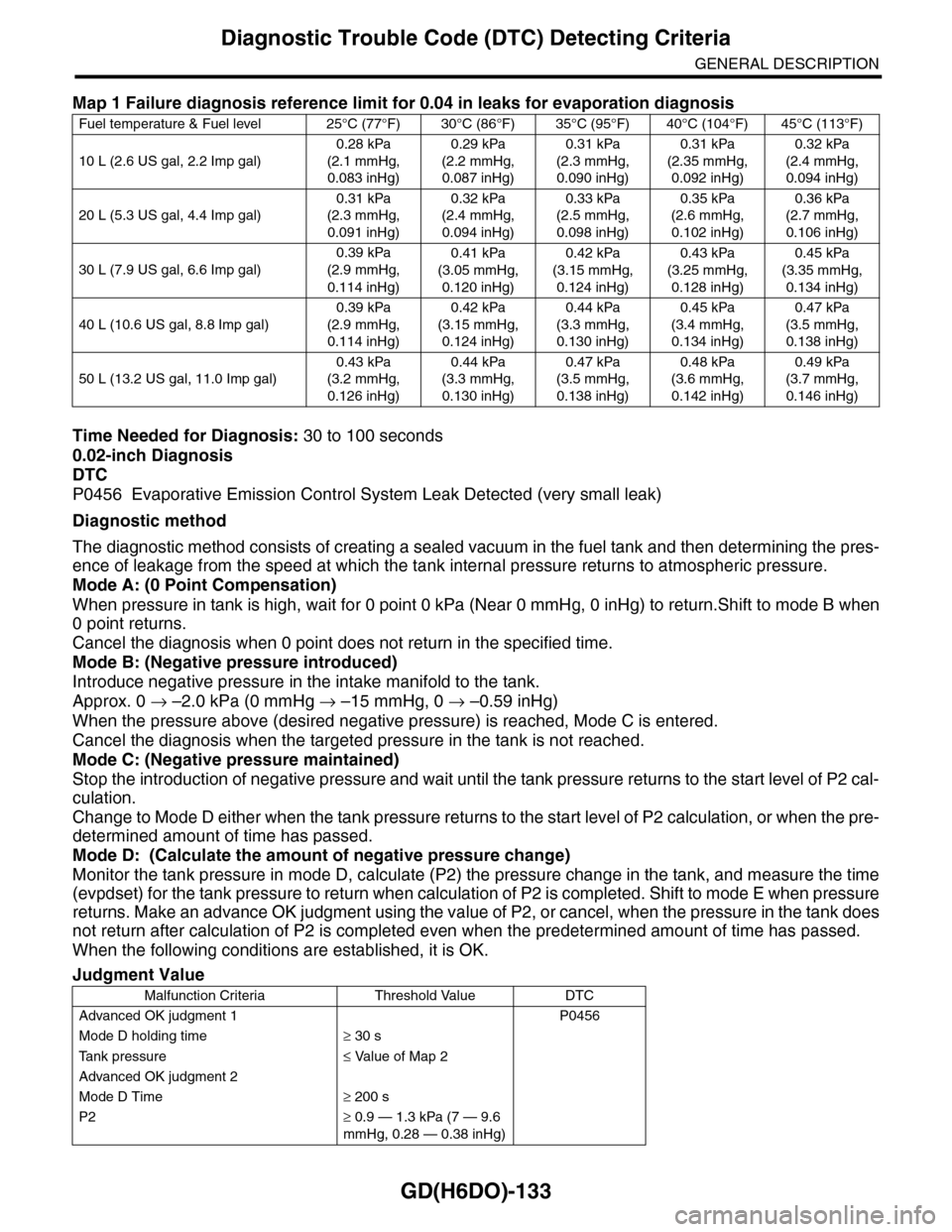
GD(H6DO)-133
Diagnostic Trouble Code (DTC) Detecting Criteria
GENERAL DESCRIPTION
Time Needed for Diagnosis: 30 to 100 seconds
0.02-inch Diagnosis
DTC
P0456 Evaporative Emission Control System Leak Detected (very small leak)
Diagnostic method
The diagnostic method consists of creating a sealed vacuum in the fuel tank and then determining the pres-
ence of leakage from the speed at which the tank internal pressure returns to atmospheric pressure.
Mode A: (0 Point Compensation)
When pressure in tank is high, wait for 0 point 0 kPa (Near 0 mmHg, 0 inHg) to return.Shift to mode B when
0 point returns.
Cancel the diagnosis when 0 point does not return in the specified time.
Mode B: (Negative pressure introduced)
Introduce negative pressure in the intake manifold to the tank.
Approx. 0 → –2.0 kPa (0 mmHg → –15 mmHg, 0 → –0.59 inHg)
When the pressure above (desired negative pressure) is reached, Mode C is entered.
Cancel the diagnosis when the targeted pressure in the tank is not reached.
Mode C: (Negative pressure maintained)
Stop the introduction of negative pressure and wait until the tank pressure returns to the start level of P2 cal-
culation.
Change to Mode D either when the tank pressure returns to the start level of P2 calculation, or when the pre-
determined amount of time has passed.
Mode D: (Calculate the amount of negative pressure change)
Monitor the tank pressure in mode D, calculate (P2) the pressure change in the tank, and measure the time
(evpdset) for the tank pressure to return when calculation of P2 is completed. Shift to mode E when pressure
returns. Make an advance OK judgment using the value of P2, or cancel, when the pressure in the tank does
not return after calculation of P2 is completed even when the predetermined amount of time has passed.
When the following conditions are established, it is OK.
Map 1 Failure diagnosis reference limit for 0.04 in leaks for evaporation diagnosis
Fuel temperature & Fuel level 25°C (77°F) 30°C (86°F) 35°C (95°F) 40°C (104°F) 45°C (113°F)
10 L (2.6 US gal, 2.2 Imp gal)
0.28 kPa
(2.1 mmHg,
0.083 inHg)
0.29 kPa
(2.2 mmHg,
0.087 inHg)
0.31 kPa
(2.3 mmHg,
0.090 inHg)
0.31 kPa
(2.35 mmHg,
0.092 inHg)
0.32 kPa
(2.4 mmHg,
0.094 inHg)
20 L (5.3 US gal, 4.4 Imp gal)
0.31 kPa
(2.3 mmHg,
0.091 inHg)
0.32 kPa
(2.4 mmHg,
0.094 inHg)
0.33 kPa
(2.5 mmHg,
0.098 inHg)
0.35 kPa
(2.6 mmHg,
0.102 inHg)
0.36 kPa
(2.7 mmHg,
0.106 inHg)
30 L (7.9 US gal, 6.6 Imp gal)
0.39 kPa
(2.9 mmHg,
0.114 inHg)
0.41 kPa
(3.05 mmHg,
0.120 inHg)
0.42 kPa
(3.15 mmHg,
0.124 inHg)
0.43 kPa
(3.25 mmHg,
0.128 inHg)
0.45 kPa
(3.35 mmHg,
0.134 inHg)
40 L (10.6 US gal, 8.8 Imp gal)
0.39 kPa
(2.9 mmHg,
0.114 inHg)
0.42 kPa
(3.15 mmHg,
0.124 inHg)
0.44 kPa
(3.3 mmHg,
0.130 inHg)
0.45 kPa
(3.4 mmHg,
0.134 inHg)
0.47 kPa
(3.5 mmHg,
0.138 inHg)
50 L (13.2 US gal, 11.0 Imp gal)
0.43 kPa
(3.2 mmHg,
0.126 inHg)
0.44 kPa
(3.3 mmHg,
0.130 inHg)
0.47 kPa
(3.5 mmHg,
0.138 inHg)
0.48 kPa
(3.6 mmHg,
0.142 inHg)
0.49 kPa
(3.7 mmHg,
0.146 inHg)
Judgment Value
Malfunction Criteria Threshold Value DTC
Advanced OK judgment 1 P0456
Mode D holding time≥ 30 s
Ta n k p r e s s u r e≤ Value of Map 2
Advanced OK judgment 2
Mode D Time≥ 200 s
P2≥ 0.9 — 1.3 kPa (7 — 9.6
mmHg, 0.28 — 0.38 inHg)
Page 1759 of 2453
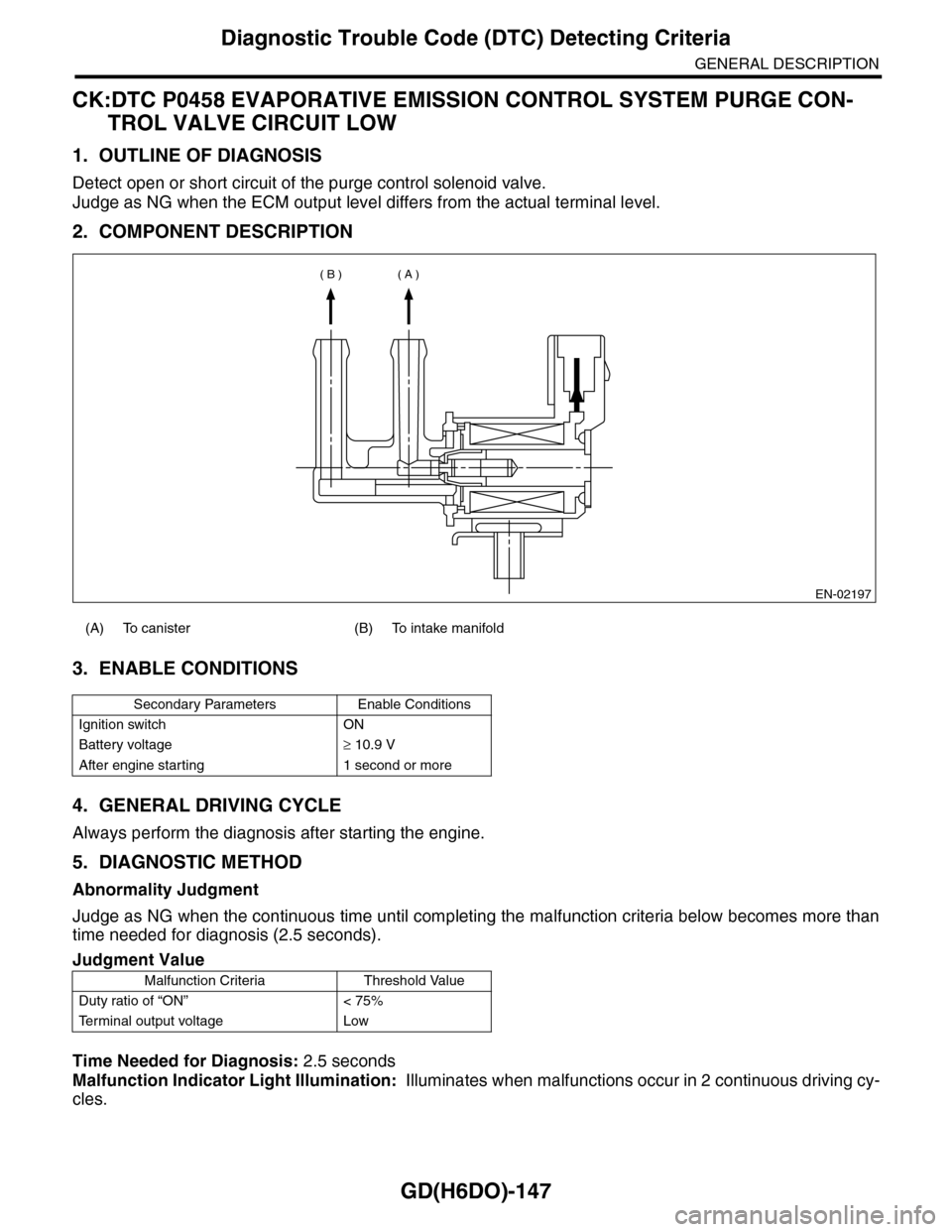
GD(H6DO)-147
Diagnostic Trouble Code (DTC) Detecting Criteria
GENERAL DESCRIPTION
CK:DTC P0458 EVAPORATIVE EMISSION CONTROL SYSTEM PURGE CON-
TROL VALVE CIRCUIT LOW
1. OUTLINE OF DIAGNOSIS
Detect open or short circuit of the purge control solenoid valve.
Judge as NG when the ECM output level differs from the actual terminal level.
2. COMPONENT DESCRIPTION
3. ENABLE CONDITIONS
4. GENERAL DRIVING CYCLE
Always perform the diagnosis after starting the engine.
5. DIAGNOSTIC METHOD
Abnormality Judgment
Judge as NG when the continuous time until completing the malfunction criteria below becomes more than
time needed for diagnosis (2.5 seconds).
Time Needed for Diagnosis: 2.5 seconds
Malfunction Indicator Light Illumination: Illuminates when malfunctions occur in 2 continuous driving cy-
cles.
(A) To canister (B) To intake manifold
Secondary Parameters Enable Conditions
Ignition switch ON
Battery voltage≥ 10.9 V
After engine starting 1 second or more
Judgment Value
Malfunction Criteria Threshold Value
Duty ratio of “ON” < 75%
Te r m i n a l o u t p u t v o l t a g e L o w
EN-02197
( A )( B )